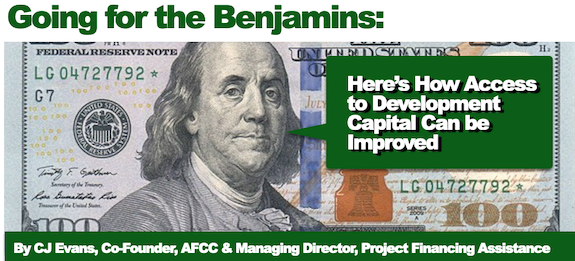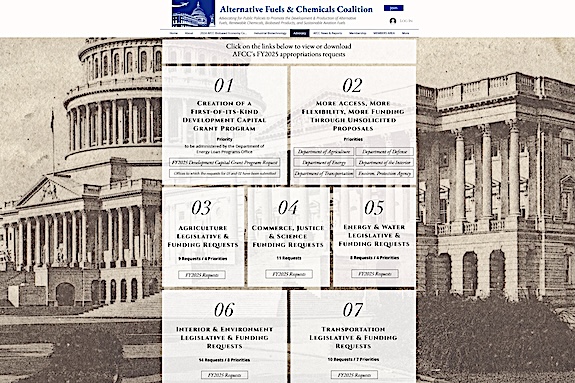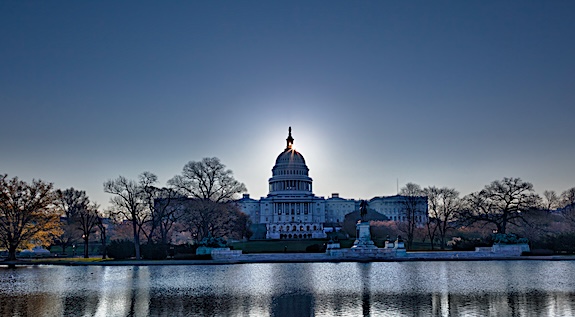Going for the Benjamins: Here’s How Access to Development Capital Can be Improved

By CJ Evans, Co-Founder, Alternative Fuels & Chemicals Coalition & Managing Director, Project Financing Assistance
Special to The Digest
The Alternative Fuels & Chemicals Coalition (AFCC) has drafted legislation to create a $500 million development capital grant program in the Department of Energy’s (DOE’s) Loan Programs Office (LPO). You can help AFCC push this request through Congress.

CJ Evans, Co-Founder, AFCC & Managing Director, Project Financing Assistance
The largest obstacle in gaining acceptance of this request, and moving it forward through Congress, will be the cost of its first and second years which, together, will amount to $1 billion.
But that is just the first two years, after that it will start making money for the U.S. government … a lot of money.
Here’s why: the funds for the grant program will be drawn from the interest that is earned by the U.S. Treasury each year on the repayment of the DOE Title 17 Clean Energy Financing loan guarantees.
According to the LPO’s 2022 Annual Portfolio Status Report:
- The FY2022 repayments generated $523 million in interest, along with $1.7 billion in principal retirement.
- In fact, since the issuance of the first loan guarantee obligations in 2009, the Title 17 repayments have totaled $13.7 billion (43% of the total funds distributed) and generated $4.3 billion in interest payments to the U.S. Treasury.
The Title 17 program was established by Congress through the Energy Policy Act of 2005. It has been characterized as a “bridge over the valley of death” (and, mor recently, as a “bridge to bankability”).
This is because it was created specifically to assume the risks of first-of-their-kind projects, which have a high failure rate, which private sector lenders are unwilling to undertake.
The Title 17 program has, in undertaking the risks inherent in first-of-their-kind projects, experienced failures and losses. It has been roundly criticized by Members of Congress and previous administrations (even though it was established to take on risks … and, therefore, experience losses … so that projects can advance that can do so in no other way).
Because comprehensive due diligence (for which the LPO has been criticized by applicants for how long this takes) the LPO has greatly limited these losses:
- By the end of FY2022 Title 17 program had $35.16 billion in outstanding loans.
- Its write offs and losses, beginning with its first project deployments in 2019, amount to $1.035.
- This represents 3% of the Title 17 total disbursements
- Significantly, these losses represent less than one-quarter of the interest payments generated by the Title 17 program and earned the U.S. Treasury.
As the LPO states in its FY2022 annual report, “The central challenge the United States faces in reaching its climate goals is a deployment challenge—not an invention challenge.”
The Development Capital grant program will address this deployment challenge. It will award grants on a competitive, 50/50 matching basis. Projects that receive awards will have the potential, in the estimation of the LPO, to qualify for the Title 17 loan guarantee program upon completion of their final Technology Readiness Level (TRL) development and pre-construction steps. The Development Capital Grant Program will:
- Provide greater certainty to companies seeking to advance innovations.
- Allow companies to complete their TRL development and pre-construction steps, advancing to the stage where they can meet the Title 17 application requirements.
- Ensure that a greater number of projects can follow a bridge to bankability … across the “valley of death,” between the validation of a significantly improved, first-of-its-kind technology and its readiness to apply to the Title 17 program to finance construction and first commercial deployment.
- Be viewed favorably by private sector investors.
The Development Capital Grant Program Will Become Self-Sustaining … and Generate Additional Revenues for the U.S. Treasury
AFCC proposes that the funds for the Development Capital grant program be drawn from the interest payments generated by the repayments of the Title 17 obligations. These funds will be used to accelerate the development of projects that can qualify for the Title 17 program. This will:
- increase the number of projects that receive financing through Title 17
- increase the number of innovative projects that are deployed
- increase the number of jobs that are created
- increase economic growth and tax revenues in local communities
- increase the Nation’s global competitiveness
- increase the Nation’s ability to address climate change
- increase the number of Title 17 repayments to the U.S. Treasury
and
- increase the amount of interest generated for the U.S. Treasury by these repayments
According to the LPO, the LPO had 15 active projects as of September 30, 2022, representing $36.3 billion in loan and loan guarantee commitments, with eight previous loans repaid in full, and interest earnings for the U.S. Treasury of $523 million.
For purposes of illustration: at the end of January 2024, the LPO had 205 active applications with $263.1 billion in loans requested. If half of these project are deployed within the next two years (FY2026), they would add $131.5 billion in loan obligations, for a total of $167.8 billion in repayments to the U.S. Treasury.
- The interest earned by the U.S. Treasury on these loan obligations would amount to $2.42 billion in FY2027.
- Thus, the U.S. Treasury would be able to:
- recover the funds that are used to establish and fund the Development Capital grant program in FY2025-26 ($1 billion)
- increase funding for the Development Capital grant program to $1 billion per year in FY2027
- earn $420 million in interest in FY2027, and
- provide $1 billion for the Development Capital grant program in FY2028 (and going forward) while earning $1.4 billion in interest in FY2028, with ever increasing collections in subsequent years.
Thus, in as little as three years, the establishment, continuation, and expansion of the Development Grant program, combined with the number of projects being funded by Title 17, could triple the amount of interest earned by the U.S. Treasury.


AFCC’s proposed amendment to the Title 17 program will be inserted in the appropriations language to cover the administrative costs of the program that has been enacted in more or less the same form every year for the past 15 years. The language proposed by AFCC reads in part that:
“$500,000,000 is appropriated, to remain available until September 30, 2026, which shall be used to provide development capital grants, through a competitive process, to projects that have the potential, in the estimation of the Department of Energy, to qualify for the Title 17 loan guarantee program upon completion of their final technology readiness level development and pre-construction steps, with said grants awarded on a competitive 50/50 matching basis to selected projects to advance to the stage where they can apply under the Title 17 loan guarantee program to stimulate (1) an increase in the number of significantly improved and first-of-their-kind technologies that can be commercially deployed, (2) an increase in the sums received by the general fund from borrowers, and (3) an increase in the interest collected by the general fund on said sums, so that the cost of the development capital grant program is offset by the additional collections by the general fund.”
Why This Grant Program is Important
Every project being developed – every one that is needed to mitigate the climate crisis – only can advance with infusions, sometimes large infusions, of development capital.
For example, a typical $1 billion biomass-to-sustainable-aviation-fuel (SAF) project may require $50 million or more in development capital to move the project through permitting and Front-End Engineering and Design (FEED) to a final investment decision (FID).
Without this development capital, it can’t move forward … and delays in securing development capital result in years-long, and sometimes decade-long delays in a project’s timeline and deployment.

Brightly lit dawn sky behind the illuminated dome of the Capitol in Washington DC with the pool and statues
Some projects never reach the point where they can address the climate crisis – or provide their other benefits to society … which we will never know about or be able to enjoy – because they end up being unrealized dreams due to the lack of the money that was necessary for them to continue.
Although federal grants provide funds for project development, such funding only can be used to meet the restrictions and carry out the objectives of the grant, rather than advancing the unique needs of the project.
Therefore, development capital, to the degree it is provided, is, at most, an after-thought, a byproduct of a grant.
There is no federal funding that addresses this specific need, let alone that provides development capital that meets the unique needs of each project so it can advance.
This is why AFCC is proposing that a development capital grant program be established within the LPO:
- to meet the specific needs of each project
- to advance disruptive, game-changing projects more quickly and less haphazardly
- to meet the requirements of the Title 17 Clean Energy Financing program
- to be deployed, not in 8 or 10 years, but in 4 or 5 (or fewer) years
- and, thus, provide their benefits to the American people
- creating jobs
- providing economic stimulus to local communities
- generating tax revenues
- advancing the Nation’s competitiveness
and
- addressing the climate crisis.
You can help AFCC add this language to the Department of Energy FY2025 appropriations.
Category: Top Stories















